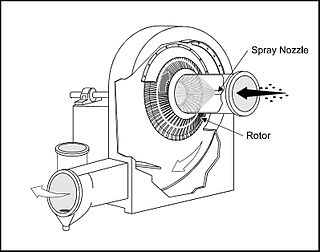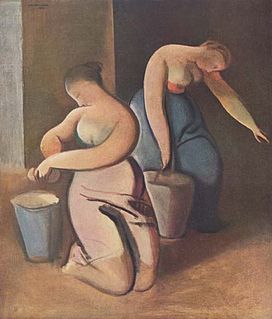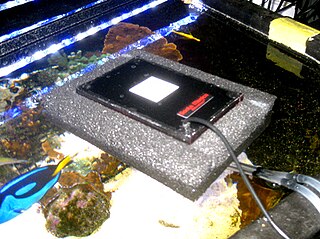
A rebreather is a breathing apparatus that absorbs the carbon dioxide of a user's exhaled breath to permit the rebreathing (recycling) of the substantially unused oxygen content, and unused inert content when present, of each breath. Oxygen is added to replenish the amount metabolised by the user. This differs from open-circuit breathing apparatus, where the exhaled gas is discharged directly into the environment. The purpose is to extend the breathing endurance of a limited gas supply, and, for covert military use by frogmen or observation of underwater life, eliminating the bubbles produced by an open circuit system. A rebreather is generally understood to be a portable unit carried by the user. The same technology on a vehicle or non-mobile installation is more likely to be referred to as a life-support system.

A brush is a common tool with bristles, wire or other filaments. It generally consists of a handle or block to which filaments are affixed in either a parallel or perpendicular orientation, depending on the way the brush is to be gripped during use. The material of both the block and bristles or filaments is chosen to withstand hazards of its intended use, such as corrosive chemicals, heat or abrasion. It is used for cleaning, grooming hair, make up, painting, surface finishing and for many other purposes. It is one of the most basic and versatile tools in use today, and the average household may contain several dozen varieties.

Flue-gas desulfurization (FGD) is a set of technologies used to remove sulfur dioxide from exhaust flue gases of fossil-fuel power plants, and from the emissions of other sulfur oxide emitting processes such as waste incineration.
Scrubber systems are a diverse group of air pollution control devices that can be used to remove some particulates and/or gases from industrial exhaust streams. The first air scrubber was designed to remove carbon dioxide from the air of an early submarine, the Ictineo I, a role for which they continue to be used today. Traditionally, the term "scrubber" has referred to pollution control devices that use liquid to wash unwanted pollutants from a gas stream. Recently, the term has also been used to describe systems that inject a dry reagent or slurry into a dirty exhaust stream to "wash out" acid gases. Scrubbers are one of the primary devices that control gaseous emissions, especially acid gases. Scrubbers can also be used for heat recovery from hot gases by flue-gas condensation. They are also used for the high flows in solar, PV, or LED processes.

A dust collector is a system used to enhance the quality of air released from industrial and commercial processes by collecting dust and other impurities from air or gas. Designed to handle high-volume dust loads, a dust collector system consists of a blower, dust filter, a filter-cleaning system, and a dust receptacle or dust removal system. It is distinguished from air purifiers, which use disposable filters to remove dust.

A water eductor or water dredge is an eductor-jet pump-based tool used by underwater archaeologists to remove sediments from an underwater archaeological site. Airlifts may be used for the same purpose.

Selig Percy Amoils, FRCS, born 1933, is a South African ophthalmologist and biomedical engineering inventor. In 1965, Amoils refined the cryoextraction method of cataract surgery by developing a cryoprobe that was cooled through the Joule-Thomson effect of gas expansion. His system is still widely used in the fields of ophthalmology and gynaecology.

Mechanically aided scrubbers are a form of pollution control technology. This type of technology is a part of the group of air pollution controls collectively referred to as wet scrubbers.
The term wet scrubber describes a variety of devices that remove pollutants from a furnace flue gas or from other gas streams. In a wet scrubber, the polluted gas stream is brought into contact with the scrubbing liquid, by spraying it with the liquid, by forcing it through a pool of liquid, or by some other contact method, so as to remove the pollutants.
Pot washing is the process of cleaning low to heavily baked-on items off of restaurant kitchen food equipment, including pots, pans, trays, tubs and more.

Floor cleaning is a major occupation throughout the world. The main job of most cleaners is to clean floors.

Scrubbers is a 1982 British drama film directed by Mai Zetterling and starring Amanda York and Chrissie Cotterill. It was shot primarily in Virginia Water, Surrey, England. It was inspired by the success of the 1979 film Scum.

An algae scrubber is a water filtering device which uses light to grow algae; in this process, undesirable chemicals are removed from the water. Algae scrubbers allow saltwater, freshwater and pond hobbyists to operate their tanks using natural filtration in the form of primary production, much like oceans and lakes.

A floor scrubber is a floor cleaning device. It can be a simple tool such as a floor mop or floor brush, or in the form of a walk-behind or a ride-on machine to clean larger areas by injecting water with cleaning solution, scrubbing, and lifting the reside off the floor. With advancements in robotics, autonomous floor-scrubbing robots are available as well.

Rebreather diving is underwater diving using rebreathers, which recirculate the breathing gas already used by the diver after replacing oxygen used by the diver and removing the carbon dioxide metabolic product. Rebreather diving is used by recreational, military and scientific divers in applications where it has advantages over open circuit scuba, and surface supply of breathing gas is impracticable. The main advantages of rebreather diving are extended gas endurance, and lack of bubbles.

The Halcyon Passive, Variable Ratio-Biased Addition Semi-Closed rebreather is a unique design of semi-closed rebreather using a depth-compensated passive gas addition system. Passive addition implies that in steady state operation addition of fresh feed gas is a response to low volume of gas in the loop - the gas is injected when the top of the counterlung activates a demand type addition valve, which provides feed gas as long as the diver continues to inhale. The mechanism discharges gas to the environment in proportion to breathing volume to induce this gas feed.
The Dräger Ray is a semi-closed circuit recreational diving rebreather designed to use standard nitrox breathing gas mixtures.

A scrubber, is a type of wide brush with a long shaft used for cleaning hard floors or surfaces. Unlike a broom, which has soft bristles to sweep dirt away, a scrubber has hard bristles for brushing. It may therefore be used wet, with water or cleaning fluids. Around the brush head there may also be a removable floorcloth or mop, either soaked in water for cleaning or dry for wiping dry. However, these days other cleaning implements tend to be used for such purposes.













